Bosch WFL2000AU, WFL1600SG, WFL1660SG, WFL1600ID, WFL2080AU Manual
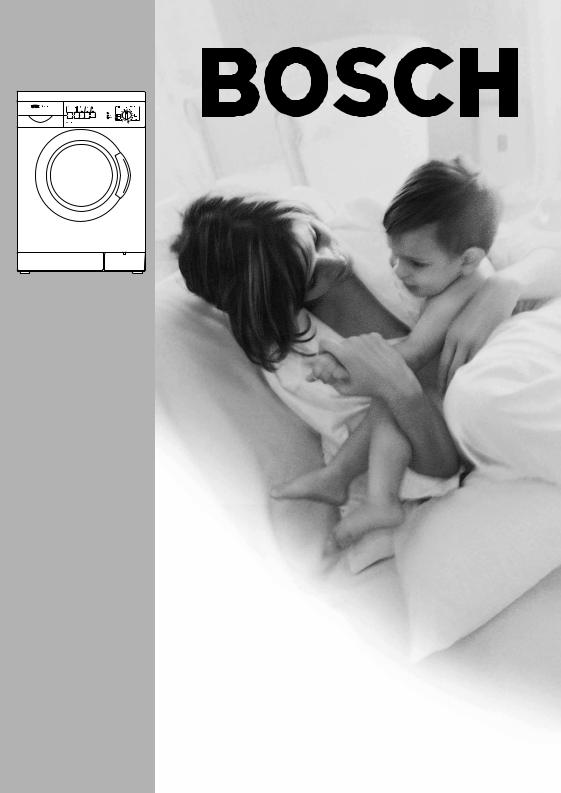
WFL 16..
en Instruction Manual and Installation Instructions
Internet:
http://www. bosch-hausgeraete.de
2

Table of Contents
Operating
Instructions
Installation
Instructions
General . . . . . . . . . . . . . . . . . . 4. . .
Disposal Information . . . . . . . . . . . . . .5 . . Safety instructions. . . . . . . . . . . . . . .6 . .
Environmental Protection /
Conservation Issues. . . . . . . . . . . . . . 7. . Your New Washing Machine. . . . . . . . . . . .8 .
Before Using Your Washing Machine
For the First Time. . . . . . . . . . . . . . . .10.
Preparing the laundry. . . . . . . . . . . . . 11. . .
Sorting the laundry. . . . . . . . . . . . . . .12. . Loading the laundry. . . . . . . . . . . . . . 15. .
Laundry Detergents |
and Additives. . . . |
. . . . |
16. . . |
Programmes and functions. . . . . . . . . . . |
18. . |
||
Washing . . . . . |
. . . . . . . . . |
. . . 22. . . . |
|
When the Programme has Ended. . . . . . . . . 24. . Special Applications. . . . . . . . . . . . . .25. . Cleaning and Care. . . . . . . . . . . . . . .27. . Troubleshooting Minor Faults. . . . . . . . . . 32. . .
Customer service. . . . . . . . . . . . . . .35. . Consumption Rates. . . . . . . . . . . . . .36. . Installation, Connection and Transport. . . . . . 37. .
3

General
The new washing machine which you have just |
|||||
purchased is a modern, |
high'quality domestic |
|
|||
appliance. |
|
|
|
|
|
Your washing appliance is distinguished by its eco' |
|||||
nomical consumption of power, water and detergent. |
|||||
Each washing machine which leaves our factory has |
|||||
undergone a thorough performance test and is in fu |
|||||
working order. If you have any queries - especially |
|||||
concerning installation |
of |
the |
washing |
machine |
- |
our customer service |
will |
be |
happy to |
advise |
you. |
Further information and a selection of our |
products |
can be found on our Internet page: |
|
http://www.bosch'hausgeraete.de |
|
Please read and observe these operating |
and installa |
tion instructions and all other information |
enclosed |
with the washing machine. |
|
Keep all documentation in a safe place for subse' quent use or for the next owner of the appliance.
4

Disposal Information
Disposing of the packaging
Disposing of your old appliance
The shipping package has protected your new ap# pliance on its way to your home. All packaging ma als are environment#friendly and recyclable. Please contribute to a better environment by disposing of packaging materials in an environmentally conscious manner.
Please ask your dealer or local authority about best means of disposal.
d Danger of |
suffocation! |
|
|
Keep |
children |
away from |
shipping carton and packa |
ging |
components. Danger |
of suffocation from folding |
|
cartons and plastic film.
Old appliances are not worthless rubbish! Environment#conscious recycling can reclaim valuable raw materials.
d Danger of fatal injury!
On out#of service appliances, unplug mains plug.
Cut off power cord |
and discard |
with mains |
plug. |
To prevent playing |
children from |
becoming |
trapped |
and endangered, ensure that the door locking mechanism is disabled.
5

Safety instructions
q Your washing machine is intended: - For domestic use only.
-For washing machine$washable fabrics in washing lye.
-For operation with cold drinking water and commercially available detergents and cleaning products which are suitable for use in front$ loader$washing machines.
q Never leave |
children unattended in the proximity |
the washing |
machine. |
q The appliance is not itended for use by young children or infirm persons without supervision.
q Keep domestic pets away from the washing machine.
q Do |
not |
touch the loading door when washing at |
high |
temperatures. |
|
q Do |
not |
insert / remove the mains plug with wet |
damp hands.
q Handle the plug only when removing from the socket.
q Take care when draining hot washing solution.
q Do not climb onto the washing machine or lean against the opened loading door.
6

Environmental |
Protection / |
||
Conservation |
Issues |
|
|
Your washing |
machine uses water, energy and dete |
||
gent efficiently, |
thereby protecting the environment |
||
and |
reducing |
your |
household costs. See Page 36 fo |
consumption values |
of your appliance. |
||
Using your washing machine in an efficient and en ronmentally friendly manner:
q Do not exceed recommended load. |
|
|
||||
Cottons+Linens |
|
6.5 |
kg/ |
14.3 |
lb |
|
Easy3care |
|
3.5 |
kg/ |
7.7 |
lb |
|
Delicates and Woollens |
2.0 kg / 4.4 lb |
|||||
q Where |
possible, |
use the60 °C |
Linens |
Intensive |
||
Stains |
programme instead |
of 90the°C |
Cottons |
|||
programme. The |
extended |
washing time achieves |
||||
a cleaning result |
comparable |
to that of °theC 90 |
||||
programme, but |
uses considerably less energy. |
|||||
q Avoid using the Prewash programme when washing lightly to normally soiled laundry.
q Add detergent according to the degree of soiling amount of laundry and water hardness, and ob3 serve the detergent manufacturer's instructions.
7
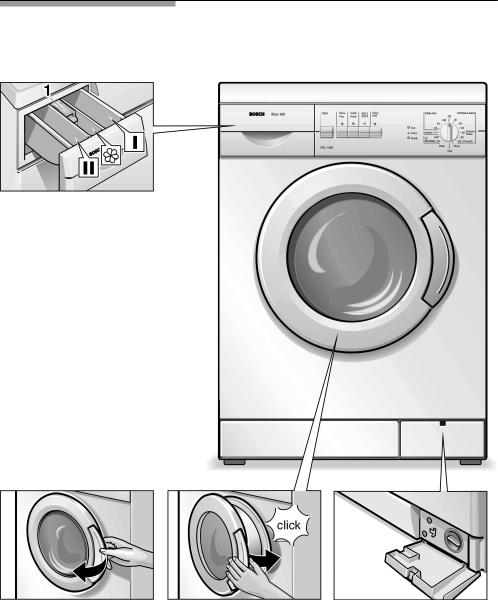
Your New Washing Machine
Filling laundry detergent and/or additive dispensers
Dispenser I:
Detergent for prewash or starch.
Dispenser II:
Detergent for main wash, water softener, pre soaking agent, bleach and stain removal product.
Dispenser 2:
Additives, |
e.g. fabric softener |
or former |
(fill no higher than lower |
edge of |
insert1). |
Opening ... |
and closing the door |
Draining |
the |
washing |
|
|
solution, |
if |
required. |
8
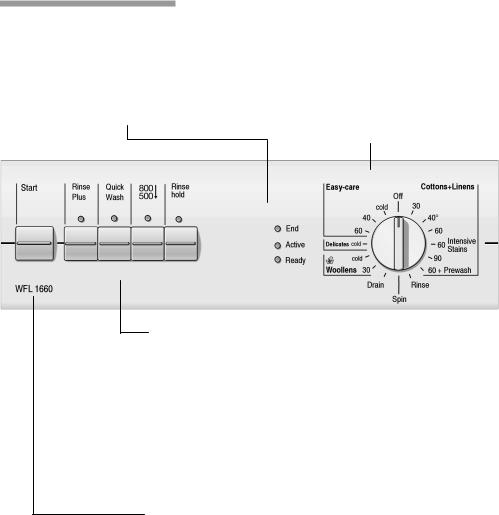
Control panel
2. Indicator lights are on
End when programme is finished. Active whenStart is pressed.
Ready, if the programme is selected. Indicator lights flash: Operation error.
1. |
Select |
a |
programme |
|
Switches |
on / off the washing machine. |
|||
Can be rotated in either |
direction. |
|||
The |
programme selector |
does not rotate while |
||
the programme is running the programme |
||||
sequence |
is |
electronically |
controlled. |
|
3. |
Press |
buttons |
for additional |
options |
|
|
|
|
|
|||||
(in addition to the programme if required) |
|
|
|
|
||||||||||
Rinse Plus: Extra rinse cycle |
|
|
|
|
|
|
|
|||||||
Quick Wash: Reduced programme duration |
|
|
|
|
|
|||||||||
{: |
|
Reduced |
|
spin |
speed |
|
|
|
|
|
|
|||
Rinse hold: Laundry is left in rinsing water |
|
|
|
|
||||||||||
Additional |
options |
can |
be |
combined before the |
programme |
is |
started. |
|||||||
The |
indicator |
lights |
of |
the |
buttons |
come |
on, if |
the |
additional |
options |
||||
are |
active. |
|
|
|
|
|
|
|
|
|
|
|
|
|
Switch off |
additional |
option: |
press |
button |
again. |
|
|
|
|
|||||
4. Press the Start button |
|
|
|
|
|
|
|
|||||||
The |
washing |
process |
begins |
(programme |
must |
have |
been |
selected). |
||||||
9

Before Using Your Washing
Machine For the First Time
Caution
The washing machine must have been installed and
connected |
properly (refer |
to Page 37). |
|
Your appliance |
was tested before leaving the factor |
||
To remove |
any |
water left |
over from testing procedu |
res, the first washing cycle should be carried out
without |
laundry |
in |
the |
machine. |
|
|
|
||||||
i |
Do |
not |
load |
any |
|
laundry. |
|
|
|
||||
1. |
Turn |
on |
water |
tap. |
|
|
|
|
|
|
|||
2. |
Pull |
out |
the |
detergent |
dispenser |
up to |
the end |
||||||
|
stop. |
|
|
|
|
|
|
|
|
|
|
|
|
3. |
Pour |
approx. |
1 litre |
|
/ |
1 ¾ pt |
of |
water |
into |
||||
|
chamber II |
of |
the |
detergent |
dispenser. |
|
|||||||
4. |
Pour |
½ measuring |
beaker |
of |
detergent |
into |
|||||||
|
dispenser II. |
Do |
not |
use |
any special detergents |
||||||||
|
for delicates |
or |
woollens |
(excessive foam). |
|||||||||
5. |
Close the |
detergent |
dispenser. |
|
|
||||||||
6. Set |
the |
programme |
selector90to°C Cottons. |
||||||||||
|
The Ready |
indicator |
light |
is |
on. |
|
|
||||||
7.Press theStart button.
The Active indicator light is on.
When theEnd control light comes on:
8. Turn the programme selectorOffto.
10
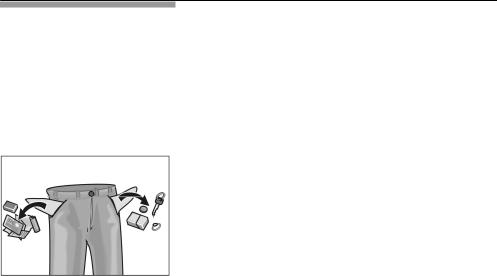
Preparing the laundry
Caution
Loose debris (e.g. coins, paper clips, needles, nails) can damage items of clothing as well as parts of washing machine (e.g. drum).
q Empty |
all pockets on items of clothing. |
|
q Brush |
out any sand from pockets and |
cuffs. |
q Close |
zip*fasteners and button up bed |
covers. |
q Remove curtain runners or tie them up |
in a net |
|
bag. |
|
|
q The following items must be washed inside a ne pillow case:
-Extremely delicate items, e.g. fine tights, net curtains.
- Small items, e.g. small socks or handkerchiefs.
- Underwired bras (the wire may come loose during washing and cause damage).
q When washing trousers, knitwear and woven
fabrics, e.g. shirts, |
T*shirts or sweatshirts, always |
turn these items |
inside out. |
11
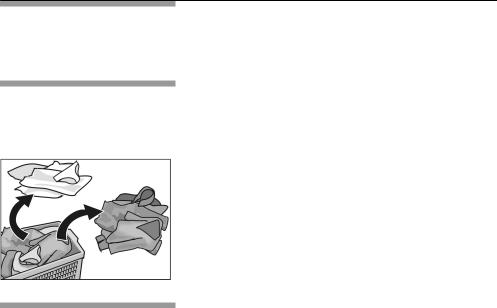
Sorting the laundry
Caution
According to colourItems of clothing can become discoloured. Never wash new multi(coloured items together with other items.
White items may become grey. Always wash white and coloured items separately.
According |
|
|
|
|
|
|
|
|
|
to degree of |
dirt |
|
|
|
|
|
|
|
|
Slight dirt |
No |
recognizable dirt or |
staining. Laundry |
may |
have |
||||
|
some body odour. |
|
|
|
|
||||
|
- Light summer clothing and sportswear |
that has |
|||||||
|
|
only |
been worn for |
a few |
hours. |
|
|
||
|
- |
T(shirts, |
shirts |
and blouses |
that have |
been |
worn |
||
|
|
for |
up |
to one |
day. |
|
|
|
|
|
- |
Bed |
linen and guest towels that have |
been |
used |
||||
|
|
for |
one |
day. |
|
|
|
|
|
Normal dirt |
Visible |
dirt |
and/or |
some light staining recognizable. |
||
|
- |
T(shirts, |
shirts |
and blouses that are very sweaty |
||
|
|
have |
been |
worn several times. |
||
|
- |
Underwear |
that |
has been worn for one day. |
||
|
- |
Tea |
towels, hand towels and bed linen that hav |
|||
|
|
been used |
for |
up to one week. |
||
|
- |
Net |
curtains (without nicotine staining) that have |
|||
|
|
not |
been |
washed for up½ yearto. |
||
12
Intensive dirt |
Dirt and/or staining |
recognizable. |
|
|
|
- |
Kitchen hand towels that have been used |
for up |
|
|
|
one week. |
|
|
|
- |
Fabric napkins. |
|
|
|
- |
Bibs. |
|
|
|
- |
Children's outer |
clothing or football shirts |
and |
shorts with grass and soil stains.
-Working clothes such as overalls or baker's and butcher's coats.
Typical stains |
- Skin fat, |
cooking oils / |
fat, sauces, mineral oil, |
||
|
(containing |
fat / |
oil). |
|
|
|
- Tea, coffee, red wine, fruit, vegetables |
||||
|
(bleachable). |
|
|
||
|
- Blood, egg, milk, starch |
(containing protein / |
|||
|
carbohydrate). |
|
|
||
|
- Soot, soil, sand (pigments), red sand on tennis |
||||
|
clothes. |
|
|
|
|
Removing stains |
Wherever |
possible, |
remove / |
pretreat stains whilst |
|
|
they are |
still |
fresh. |
|
|
First, dab soapy water onto the stain. Do not rub. Subsequently wash the items of clothing using the appropriate programme.
Several washing cycles may sometimes be required order to remove stubborn / dried in stains.
13
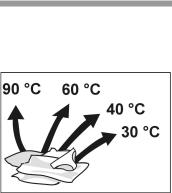
according to their care label specifications
Only |
wash laundry that is labelled with the followin |
care |
symbols: |
e d
90 °C Cottons c b a
30 °C, 40°C, 60°C Linens
h g f
cold, 40°C, 60°C Easy#care l g k f
cold Delicates
u l g k f cold, 30°C Woollensu
Laundry that is labelled with |
the following care sym |
must not be washed in the |
washing machine: |
B = do not wash |
|
14
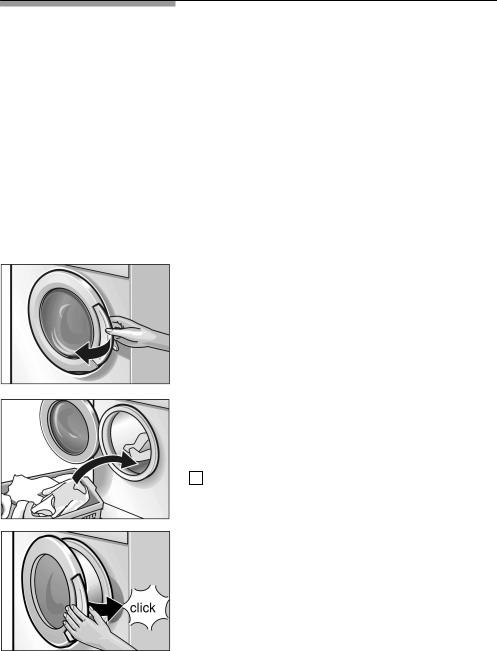
Loading the laundry
d Risk of explosion!
Items of clothing that have been pretreated with so
vent%based cleaning |
agents, |
e.g. stain remover and |
dry cleaning spirit, |
represent |
an explosion hazard |
once loaded into the washing machine. Therefore, these items must first be rinsed thoroughly by hand
Caution
Loose debris in the washing machine drum can da
mage the |
laundry. Before |
loading the laundry, chec |
that there |
is no debris in |
the drum. |
1. Open the loading door.
2.Unfold the sorted items of clothing and place th loosely into the drum. Mix large and small items
Laundry items which vary in size are more even distributed during the spin cycle.
i Do not exceed recommended load. Overloading will cause poor wash results and encourage creasing.
3.Close the loading door.
Take care not to trap any items of clothing between the loading door and rubber seal.
15
